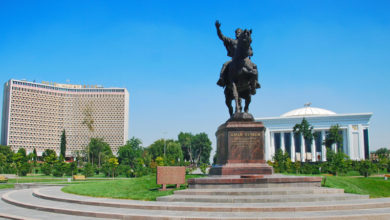Central Asia & Caucasus
Is the U.S. Preparing to Challenge Russia and China in Central Asia?

Central Asia has long been out of the sights of the United States, however, things are changing and it now appears that Washington’s interest are emerging. The Kazakh capital of Nur-Sulan hosted a high-level meeting last week between U.S. Under Secretary of State for Political Affairs, David Hale, and the foreign ministers of the Central Asian countries of Kazakhstan, Turkmenistan, Tajikistan , Uzbekistan and Kyrgyzstan, under the format of C5 + 1 (Central Asia and the U.S.).
The format was originally started by President Barack Obama in the hope of sharing the responsibilities of fixing the mess the U.S. created in Afghanistan. The U.S. had hoped that because Afghanistan is a fellow Muslim country in Central Asia, the other countries in the region could find success in bringing calm to the war torn country. However this overlooks the fact that the region has a different culture and mentality to that in Afghanistan. Even after the collapse of the Soviet Union, Central Asia remained under strong Russian influence through economic and military treaties, particularly the Organization of the Collective Security Treaty (OTSC), that includes Kyrgyzstan, Kazakhstan and Tajikistan, and previously Uzbekistan. Kyrgyzstan, Kazakhstan and Tajikistan are also members of the Eurasian Economic Union (UEE), with Kyrgyzstan, Kazakhstan. Tajikistan and Uzbekistan also members of the Commonwealth of Independent States (CIS), while Turkmenistan is an associated country.
The Russian dominance over this region is evident, however, the U.S. still seeks to undermine their influence in Central Asia. Because of these countries membership in OTSC, UEE and CIS, it has made U.S. penetration into the region an almost impossible task despite their troops nearby in Afghanistan. However, we must not forget China’s role in this.
With China bordering Kyrgyzstan, Kazakhstan and Tajikistan, Chinese influence has been steadily growing in the region in the context of the Belt and Road Initiative (BRI). With Russia and China maintaining close relations, any U.S. attempts to subvert their influence in the region will be useless.
It is because of the economic and resource potential that Central Asia can present to the BRI, and vice-versa, that these countries will prioritize China. Central Asia is rich, very rich. Kazakhstan has roughly 3% of the world’s oil, 4% of the world’s coal and 15% of the worlds uranium, along with a whole host of other metals and minerals. Turkmenistan has around 5% of the world’s gas, and large amounts of gold, copper, lead and uranium. Although the other three ‘stans are not as resource rich, they do have their fair share, but also have an important role on the new Silk Road, which just like the historical Silk Road, finds the significant importance of Central Asia as a land route between Asia and Europe.
The U.S. State Department has attempted to counteract China’s economic and commercial expansion in the region knowing that the successful implementation of the BRI will radically change the international economic system. The U.S. would rather prevent the roll out of the BRI into Central Asia. It is undeniable that the U.S. challenges China in promoting the huge logistics BRI project. The Americans may want to offer the five Central Asian republics an alternative to Russia and China, however, they have very little to offer in terms of security and trade in comparison to the aforementioned countries.
The U.S. wars in the Middle East and its aggression in the South China Sea is partially motivated by wanting to stem Russian and Chinese attention, and therefore, influence in Central Asia. By diverting Russian attention to Syria, Eastern Europe and the Caucasus, and the Chinese focus onto the South China Sea and the Korean peninsula, the U.S. can more forcefully penetrate into Central Asia, according to a report published by the Centre for Counter Hegemonic Studies. The control of Afghanistan and the removal of Saddam Hussein from Iraq would be the first moves in the strategy, the report explained.
The control of Afghanistan and Iraq has meant that U.S. military bases are now on the outskirts of Central Asia. It would not be far fetched to speculate that these military bases can be used to attempts significant pressure on the BRI and Russian influence in Central Asia and the Middle East. While the U.S. could use its military might to dominate Central Asia, it is highly unlikely that this will occur. What is certain however, the competition for Central Asia will continue between the Great Powers.





